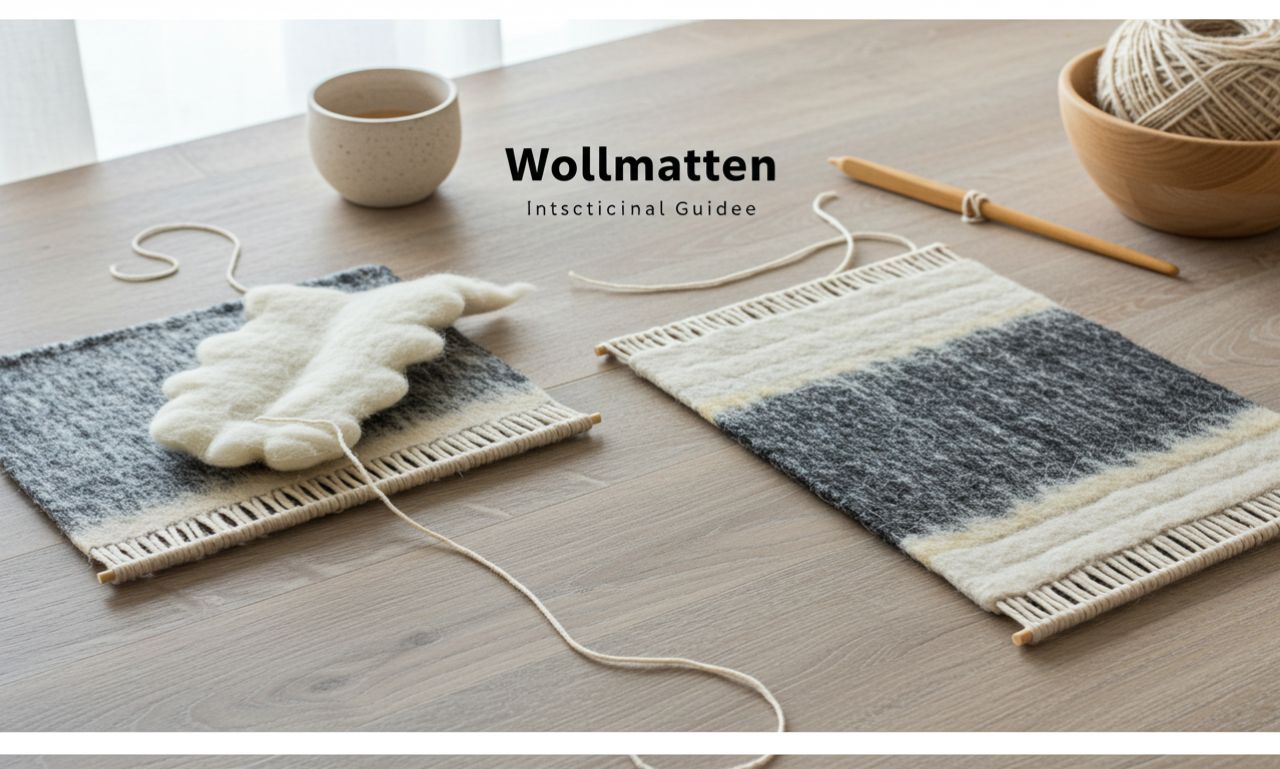The term Wollmatten, derived from German, literally means “wool mats.” It refers to natural wool-based mats widely used in insulation, construction, and design. With the growing emphasis on eco-friendly and sustainable materials, Wollmatten have become an increasingly popular choice across industries.
In this comprehensive article, we’ll explore what Woll matten are, how they’re made, their applications, and why they’re considered one of the most sustainable insulation and textile materials available today.
What Are Wollmatten?
Wollmatten are mats made primarily from natural sheep’s wool. They can be produced in various densities and thicknesses, depending on their intended use — from thermal and acoustic insulation to protective packaging and interior decoration.
Unlike synthetic mats made of plastic or fiberglass, Woll matten are 100% biodegradable, renewable, and environmentally friendly. Their natural fiber structure provides excellent insulation, moisture regulation, and air purification properties.
In essence, Woll matten combine tradition, functionality, and sustainability — a perfect representation of modern eco-design.
The Origin and History
The use of wool as an insulation and comfort material dates back thousands of years. Ancient civilizations valued wool for its warmth, softness, and resilience.
In German-speaking regions, the concept of Woll matten evolved as wool-processing industries grew during the 19th and 20th centuries. Local craftsmen discovered that compressed wool sheets could serve as powerful insulation materials for homes, barns, and even machinery.
Today, Woll matten have evolved into advanced industrial products used not only in construction but also in packaging, furniture manufacturing, and agriculture.
How Wollmatten Are Made
The production of Wollmatten involves several natural and mechanical steps that ensure both durability and purity.
1. Wool Selection
High-quality wool is sourced from sheep — often local breeds known for dense and resilient fibers. The wool is carefully sorted to remove coarse or contaminated fibers.
2. Cleaning and Processing
Raw wool contains lanolin and impurities. It is washed with eco-friendly detergents, ensuring it retains natural protective oils while removing dirt and dust.
3. Carding and Felting
The cleaned wool is carded (combed) to align the fibers and then felted through mechanical pressure, moisture, and sometimes mild heat. This process creates thick, cohesive mats — the Woll matten.
4. Finishing
Depending on the intended use, Woll matten can be treated for moth resistance, flame retardancy, or extra firmness. Some remain untreated to preserve their fully organic nature.
Types
Different forms of Woll matten exist depending on their structure and function. Below are the most common types:
1. Insulation Wollmatten
Used in building and housing projects, these mats provide thermal and acoustic insulation for walls, roofs, and floors.
2. Decorative Wollmatten
These are softer, colorful wool mats used for interior design, furniture covers, rugs, or artistic installations.
3. Agricultural Wollmatten
In farming, Woll matten serve as protective covers for plants, erosion control mats, and soil enhancers — thanks to wool’s nutrient-rich, biodegradable properties.
4. Industrial Wollmatten
Used for soundproofing machinery, packing delicate equipment, or filtering air, these mats are dense and highly durable.
Wollmatten in Construction and Architecture
1. Thermal Insulation
One of the most common uses of Woll matten is thermal insulation in eco-friendly buildings. Wool’s natural crimp traps air, making it an excellent heat regulator. Homes insulated with Woll matten stay warmer in winter and cooler in summer.
2. Acoustic Insulation
Noise pollution is a growing problem in urban environments. Woll matten absorb sound waves, reducing echoes and vibrations — ideal for studios, offices, and apartments.
3. Breathable Construction Material
Unlike synthetic insulation, Woll matten “breathe.” They regulate humidity by absorbing and releasing moisture without losing their insulating properties, contributing to healthier indoor climates.
Environmental Benefits
1. 100% Natural and Biodegradable
Made from pure sheep’s wool, Woll matten decompose naturally without harming the environment.
2. Renewable Resource
Sheep grow new fleece annually, making wool a renewable material that supports sustainable farming practices.
3. Energy Efficient Production
The energy required to produce Woll matten is significantly lower than that for synthetic alternatives like fiberglass or mineral wool.
4. Air Purification Properties
Wool fibers naturally absorb and neutralize harmful substances like formaldehyde and VOCs (volatile organic compounds), improving indoor air quality.
Comparing Wollmatten with Synthetic Insulation
| Feature | Wollmatten | Synthetic Insulation |
|---|---|---|
| Material | Natural wool | Fiberglass / Foam |
| Eco-Friendliness | 100% biodegradable | Non-biodegradable |
| Thermal Efficiency | Excellent | High but less breathable |
| Moisture Regulation | Natural humidity control | Often causes condensation |
| Health Impact | Non-toxic | Can release microplastics |
| Durability | Long-lasting | Prone to degradation over time |
Clearly, Wollmatten outperform synthetics in environmental sustainability, health safety, and comfort.
Applications Beyond Construction
1. Furniture and Interior Design
Designers use Wollmatten to create sustainable and stylish interiors. They can be used as wall panels, seating covers, or even art pieces.
2. Soundproof Studios
Recording studios and theaters utilize Wollmatten for natural acoustic damping without the need for chemical-based foams.
3. Automotive Industry
Eco-conscious car manufacturers are exploring Woll matten as sustainable sound-insulating materials for car interiors.
4. Green Packaging
In e-commerce and logistics, Woll matten are increasingly used as cushioning and temperature-regulating packaging for fragile or temperature-sensitive products.
Sustainability and the Future of Wollmatten
In an age where climate change and pollution are global concerns, materials like Woll matten represent the future of sustainable manufacturing.
1. Circular Economy
Wool-based products fit perfectly into the circular economy model. After use, Wollmatten can be composted, reused, or recycled into new materials.
2. Local Production and Economic Support
Producing Wollmatten supports local farmers and textile industries, especially in rural regions across Europe and beyond.
3. Green Building Certifications
Buildings using Wollmatten for insulation can earn higher sustainability ratings such as LEED or BREEAM certifications.
Challenges Facing Wollmatten
While Wollmatten offer numerous advantages, they also face certain challenges:
-
Higher Cost: Natural wool can be more expensive than synthetic materials.
-
Moth Sensitivity: Without proper treatment, Wollmatten can attract moths.
-
Limited Awareness: Many builders and consumers are still unaware of the benefits of wool insulation.
However, as environmental awareness grows, these challenges are being addressed through innovation, education, and increased production efficiency.
Maintenance and Longevity of Wollmatten
Caring for Wollmatten is relatively simple. They are naturally resilient, self-cleaning, and durable. Regular inspection ensures longevity:
-
Keep dry during installation to prevent mold.
-
Use moth-resistant or lanolin-rich variants for long-term protection.
-
Avoid excessive compression to maintain insulation quality.
Properly maintained, Wollmatten can last for decades without losing performance.
Why Choose Wollmatten?
Choosing Wollmatten means investing in both comfort and sustainability. The material offers:
-
Natural thermal and sound insulation.
-
Eco-friendly, renewable composition.
-
Improved indoor air quality.
-
Long-lasting performance.
-
A contribution to reducing carbon footprints.
Whether for construction, packaging, or design, Wollmatten are a symbol of responsible innovation — blending traditional craftsmanship with modern environmental goals.
Conclusion
In conclusion, Wollmatten are far more than just wool mats — they represent a philosophy of ecological balance and mindful design. Their versatility, renewable nature, and superior insulating abilities make them a cornerstone of sustainable architecture and green innovation.
As industries continue to seek alternatives to plastic-based materials, Wollmatten stand as a perfect example of how nature provides everything we need — durability, efficiency, and beauty — without compromising the planet.
By embracing Wollmatten, we take a step closer to a greener, healthier, and more harmonious future.

